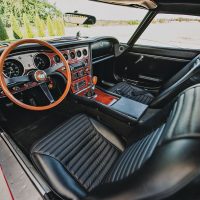SCM Analysis
Detailing
| Vehicle: | 1967 Toyota 2000GT |
| Years Produced: | 1967–70 |
| Number Produced: | 351 |
| SCM Valuation: | $912,500 |
| Tune Up Cost: | $350 |
| Chassis Number Location: | Chassis wall ID plate and stamped in left front frame behind the wheel |
| Engine Number Location: | Stamped on right side of engine block behind oil filter |
| Club Info: | Toyota Owners’ Club |
| Website: | http://toyotaownersclub.com |
| Alternatives: | 1970–73 Datsun Fairlady Z, 1961–71 Jaguar E-type, 1966–73 Porsche 911 |
| Investment Grade: | A |
This car, Lot 2215, sold for $912,500, including buyer’s premium, at RM Sotheby’s Elkhart Collection sale in Elkhart, IN, on October 24, 2020.
The Toyota 2000GT made its world debut at the 1965 Tokyo Motor Show to rave reviews and a bit of astonishment. Here was a sports car with dazzling coachwork and jewel-like build quality, a level of automotive excellence not previously seen from Japan. Until this point, Japanese automobiles had been viewed primarily as transportation appliances. The 2000GT was something altogether different. It was gorgeous, sophisticated and elegant. It was the car that transformed the world’s perception of automobiles from Japan, and deservedly so.
A brief history
In the 1960s, Nissan was working hard to raise its stature. Yamaha had a prototype sports car with a new DOHC cylinder head and was looking for a strong business partner. Nissan seriously considered working with Yamaha but eventually passed on the deal. Yamaha then brought the concept to Toyota and the 2000GT project was greenlighted.
Designed by Toyota’s Satoru Nozaki, the 2000GT was hand-built by Yamaha under contract for Toyota. Constructed as a semi-monocoque with a steel body and backbone chassis, the finished car weighed under 2,500 pounds. It possessed nearly perfect weight distribution (48/52) and boasted a slippery drag coefficient of just 0.28 Cd. The 2.0-liter inline 6-cylinder twin-cam engine produced a respectable 150 horsepower. Equipped with a 5-speed gearbox, independent front and rear suspension, light and responsive steering, and four-wheel power-assisted disc brakes, the 2000GT was meant to drive fast. Top speed was 135 mph. Few words are needed regarding the body design — it was one of the most stunning coupes of the era.
Expensive, always
Unlike models from Ferrari, Porsche, Alfa Romeo and other premium European brands, there is no enhanced value proposition to the Toyota marque. One only needs to consider the question of what the second-most-valuable production Toyota may be to fully grasp this concept. In fact, it could be said that the 2000GT has reached blue-chip collector status despite its manufacturer and nation of origin. This makes the 2000GT a bit of an anomaly in the hobby.
The 2000GT has always been expensive. When introduced in ’67, it listed for $6,800, more than the Porsche 911 ($6,050), Jaguar E-type ($5,585), and Chevrolet Corvette ($4,721). The 2000GT was nearly twice the price of Datsun’s 240Z ($3,526), which explains why Toyota struggled to sell just 66 cars in the U.S. while Nissan strained to keep pace with demand for the 240Z, selling approximately 147,000 in North America.
Nonetheless, by the 1990s, collectors were starting to appreciate the special nature of the 2000GT, with transactions in the $50,000 to $75,000 range. A decade later, cars were selling for $150,000, and by 2010, prices had tripled to $450,000. Remarkably, prices quickly doubled again and the 2000GT joined the seven-figure club in 2013 with at least five public sales over $1 million in the next few years. However, since late 2015, there has been a cooling off and a string of widely disparate hammer prices.
Six trips across the block
Having been thoroughly freshened in 2006, MF1010100 successfully participated in the 2010 Copperstate 1000 tour while owned by Brown Maloney. Maloney later consigned the car to Mecum’s Monterey sale in August 2015, when it was reported sold at $1,017,500 (SCM# 266175). It then reappeared and failed to sell at two subsequent Mecum auctions in 2016 and 2017. It appeared yet a fourth time at the May 2017 Mecum Indy sale, where it sold for $825,000 (SCM# 6838833).
These appearances raise the question of whether Mecum might have originally guaranteed Maloney a seven-figure result and had to make good on such a guarantee. If the house actually purchased the car, that would explain its three subsequent appearances. While in no way detracting from this car’s intrinsic value, its frequent auction status likely created doubt in the market. Indeed, during the car’s fifth trip across the block in August 2018 at Gooding & Company’s Monterey auction (SCM# 6877198), this very fine example sold well below expectations at $550,000.
A razor-thin market
Prices realized for 2000GTs at public auction over the past decade have fluctuated dramatically. Whereas sales exceeding $1 million seemed commonplace between 2013 and 2015, the market has clearly retreated. This makes some sense if we consider the 2000GT in the context of it being a blue-chip collectible with a razor-thin market. With very few 2000GT buyers at any given point in time, auction outcomes are at serious risk if fewer than two paddles are being raised.
Including both Series I and II body styles, a total of 351 examples of the 2000GT were produced. Of these, 94 were LHD (66 in the U.S., including 62 DOHC examples and four SOHC examples) and these cars are the most valuable. The three factory-supported Shelby SCCA race cars stand at the top of the market, carrying an SCM median value of $1.7m.
The nine LHD Series II cars that were constructed with a 2.3-liter SOHC engine are an interesting side note. Although conceived as an entry-level model, the scarcity of these cars has kept collector market values in line with the DOHC LHD cars. The RHD cars are the most plentiful, with 257 built, and trade hands at approximately 70% the value of LHD cars.
When shopping for a 2000GT, the first consideration is whether you fit. Depending on your height and inseam, saddling in with limited legroom can be a real challenge. When properly sorted, these cars are nearly bulletproof. During early production, faulty accelerator-cable and timing-chain-tensioner issues led to catastrophic engine failure in a small number of cases. These issues have been remedied in virtually all extant examples but are something worth investigating when considering a particular car.
Our subject car was prepared by the best in the business and in all regards, is a lovely twin-cam LHD example. I sincerely hope the new owner enjoys driving and showing MF1010100 for many years to come and that it will not make a seventh auction appearance anytime soon. This sale should be regarded as top of the market for a car in this condition, but it was not an unreasonable amount for the quality and pedigree of this particular example. ♦
(Introductory description courtesy of RM Sotheby’s.)



